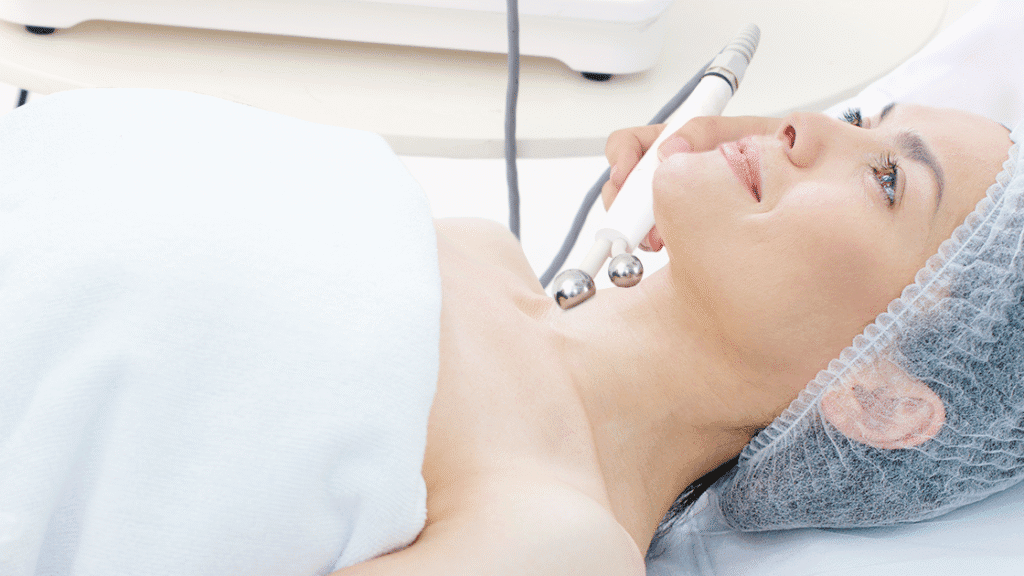1. Introduction: The Struggle with Neck Aging
The neck remains one of the most challenging areas to address in aesthetic medicine, often betraying a person’s true age despite a youthful face. While facial rejuvenation has dominated aesthetic discussions for decades, increasing awareness of comprehensive aging patterns has shifted attention to the neck and décolletage. Radiofrequency (RF) technology has emerged as a revolutionary non-surgical solution, offering patients effective skin tightening without the risks, costs, and recovery associated with traditional neck lift surgery.
1.1 Why the Neck Ages Faster Than the Face
The cervical region demonstrates accelerated aging compared to facial structures due to distinct anatomical and physiological characteristics. Neck skin contains significantly fewer sebaceous glands, resulting in reduced natural moisturization and increased susceptibility to dehydration and crepiness. The dermis in this area is thinner with less dense collagen architecture, providing less structural support against gravitational forces. Additionally, the platysma muscle—a thin, sheet-like muscle extending from jaw to clavicle—weakens and separates with age, creating visible vertical banding. Constant movement from head turning and tilting creates repetitive mechanical stress, while sun exposure from neglected photoprotection accelerates photoaging. These combined factors make the neck particularly vulnerable to premature aging manifestations.
1.2 Common Signs of Neck Aging: Sagging, Wrinkles, and Crepey Skin
Loss of collagen and elastin leads to sagging and the classic “turkey neck.”
Repeated movement deepens horizontal neck lines over time.
Vertical platysmal bands appear as neck muscles loosen and separate.
Sun damage and dehydration cause thin, crepey neck skin.
Fat buildup under the chin blurs the jawline definition.
Combined aging signs create a visibly older, less defined neck appearance.
1.3 Why More People Choose Non-Surgical Treatments
Demand for non-invasive procedures has surged as safer, faster alternatives to surgery.
Surgical neck lifts require anesthesia, high costs, and weeks of recovery.
Risks include scarring, infection, nerve injury, or the need for revision surgery.
Modern patients seek natural, gradual results that don’t disrupt daily life.
RF treatments offer visible tightening without incisions or downtime.
Non-surgical options allow early intervention before surgery becomes necessary.
2. What Is RF Skin Tightening?
Радиочастота подтяжка кожи represents a sophisticated energy-based treatment modality that has revolutionized non-surgical aesthetic medicine since its introduction in the early 2000s. This technology harnesses electromagnetic energy to generate controlled thermal effects within dermal and subdermal tissues, triggering biological responses that reverse visible aging signs. Understanding RF technology’s fundamental principles helps patients appreciate how this treatment achieves clinically significant results without invasive procedures.
2.1 How RF Energy Stimulates Collagen and Elastin
Radiofrequency devices emit electromagnetic waves, which penetrate skin and convert to thermal energy through tissue resistance. This controlled heating elevates dermal temperatures to the therapeutic range of 40-45°C (104-113°F), triggering immediate collagen fiber contraction through denaturation of triple-helix structures. More importantly, sustained thermal stress activates heat shock proteins and inflammatory cascades that stimulate fibroblast activity—the cells responsible for producing new collagen and elastin. This neocollagenesis continues for 3-6 months post-treatment as fibroblasts synthesize fresh structural proteins, gradually improving skin firmness, thickness, and elasticity. The thermal injury also promotes extracellular matrix remodeling, replacing aged, fragmented collagen with organized, functional fibers that restore youthful skin architecture.
2.2 Monopolar vs. Bipolar vs. Multipolar RF Explained
RF devices employ different electrode configurations affecting energy delivery patterns and penetration depths. Monopolar RF uses a single treatment electrode with a grounding pad placed elsewhere on the body, creating deep energy penetration reaching subcutaneous tissue and potentially superficial muscle layers—ideal for significant laxity requiring deep tissue effects. Bipolar RF positions both electrodes on the treatment handpiece, confining energy between them for controlled superficial-to-mid dermal heating with enhanced safety but less depth. Multipolar RF incorporates multiple electrode pairs simultaneously, creating complex energy matrices that heat tissue uniformly across various depths, combining safety with efficacy. Some advanced systems integrate multiple technologies—combining RF with microneedling, ultrasound, or vacuum massage—to enhance results. Treatment selection depends on patient anatomy, laxity severity, and desired outcomes, with practitioners customizing approaches accordingly.
2.3 How Controlled Heat Remodels Skin Without Downtime
The therapeutic efficacy of RF technology relies on precise thermal control—delivering sufficient heat to trigger biological responses while avoiding excessive temperatures causing burns or prolonged inflammation. Advanced RF devices incorporate real-time temperature monitoring, impedance feedback systems, and cooling mechanisms ensuring consistent, safe thermal delivery. Treatment protocols involve multiple passes over target areas with gradually increasing energy levels, allowing tissue to acclimate while accumulating therapeutic thermal doses. The controlled heating damages aged collagen structures just enough to initiate repair cascades without creating wounds requiring healing time. Skin surface remains intact throughout treatment, eliminating downtime associated with ablative procedures. Most patients experience only transient erythema and mild swelling lasting hours, allowing immediate return to normal activities—the “lunchtime procedure” appeal that drives RF popularity among busy professionals.
3. How RF Tightens and Lifts the Neck
The neck presents unique anatomical challenges requiring specialized approaches to achieve optimal tightening and lifting effects. Radiofrequency technology addresses these challenges through multiple complementary mechanisms operating at different tissue depths and timelines. Understanding these layered effects explains how RF produces both immediate and progressive improvements that collectively transform neck appearance over several months.
3.1 Heating Deep Skin Layers for Collagen Contraction
The immediate tightening effect patients notice post-treatment results from thermal collagen denaturation within the reticular dermis. When dermal temperatures reach 60-70°C, collagen’s triple-helix molecular structure partially unwinds and contracts, similar to cooking meat causing shrinkage. This instant contraction tightens existing collagen fibers, producing immediate—though modest—skin tightening visible within hours. The depth of this effect depends on RF configuration: monopolar systems reach deeper layers including fibroseptal networks connecting skin to underlying structures, while bipolar systems focus on dermal layers. This immediate response, while temporary, provides patient gratification and represents the foundation upon which longer-term collagen remodeling builds. The thermal stress also initiates inflammatory cascades essential for subsequent healing and regeneration phases.
3.2 Stimulating Long-Term Collagen and Elastin Production
The most significant and lasting RF benefits emerge from sustained neocollagenesis and elastogenesis occurring over 3-6 months post-treatment. Thermal injury triggers wound-healing cascades without creating actual wounds: heat shock proteins activate fibroblasts, transforming growth factor-beta (TGF-β) signaling increases, and matrix metalloproteinases (MMPs) activate to clear damaged proteins. Activated fibroblasts proliferate and synthesize new collagen types I and III—the structural proteins providing skin strength and firmness. Elastin production similarly increases, restoring elastic recoil allowing skin to bounce back after stretching. This newly synthesized extracellular matrix gradually replaces aged, fragmented proteins with organized, functional structures. The progressive nature explains why RF results improve continuously for months, with optimal outcomes typically visible 3-4 months post-treatment as neocollagenesis peaks.
3.3 Enhancing Skin Elasticity and Jawline Definition
Beyond tightening lax skin, RF treatment enhances overall skin quality and redefines contours lost to aging. Improved elastin networks restore skin’s ability to resist gravitational pull and return to original position after movement—the essence of youthful resilience. As dermal thickness increases through collagen deposition, skin develops better structural support preventing future sagging. The tightening effects extend beyond the neck proper to the jawline and submental region, improving cervicomental angle definition and reducing jowling that blurs jaw contours. Some RF protocols specifically target the platysma muscle layer, inducing thermal effects that may improve muscle tone and reduce vertical banding. The cumulative effect creates a lifted, sculpted appearance that subtly rejuvenates the entire lower face and neck region.
3.4 Visible Improvements: Smoother, Firmer, Lifted Skin
The multifaceted biological responses to RF treatment manifest as clinically observable improvements across multiple aging parameters. Horizontal neck lines soften as increased dermal thickness fills creases from beneath and improved elasticity prevents deepening with movement. Skin texture becomes smoother and more refined as new collagen provides structural support and improved hydration from enhanced dermal matrix. Overall firmness increases noticeably, with skin feeling thicker and more resilient to pinching. The lifting effect becomes apparent as tissue tightening counteracts gravitational descent, elevating sagging areas and creating more defined contours. Crepey texture improves as organized collagen replaces fragmented proteins and enhanced hydration plumps the skin. These changes collectively create a more youthful neck appearance that looks natural rather than artificially “done.”
4. Key Benefits of RF Neck Rejuvenation
Radiofrequency skin tightening offers numerous advantages that explain its popularity among both patients and aesthetic practitioners. These benefits extend beyond simple effectiveness to encompass safety, accessibility, convenience, and patient satisfaction factors that collectively position RF as a first-line treatment for neck rejuvenation. Understanding these advantages helps patients appreciate why RF has become the go-to non-surgical solution.
4.1 Non-Surgical and Needle-Free Skin Tightening
RF treatment’s completely non-invasive nature eliminates the inherent risks associated with surgical procedures. No incisions mean no scarring concerns, no anesthesia risks, and no surgical complications like bleeding, infection, or nerve damage. The treatment involves only external energy application through a handheld device glided across skin surfaces—no needles, no injections, no tissue disruption. This approach particularly appeals to needle-phobic individuals or those with medical conditions precluding surgery. The psychological comfort of knowing treatment involves no cutting or permanent alterations reduces anxiety and increases accessibility. Patients can pursue aesthetic enhancement without the permanent commitment surgery represents, making it ideal for first-time aesthetic treatment seekers testing non-surgical options before considering more aggressive interventions.
4.2 Minimal Discomfort and No Downtime
Treatment tolerance represents a crucial factor in patient satisfaction and adherence to recommended protocols. RF treatments produce only mild-to-moderate warmth or heating sensations that most patients describe as comfortable or easily tolerable without anesthesia. Advanced cooling systems integrated into modern RF devices protect the epidermis while delivering therapeutic heat to deeper layers, enhancing comfort significantly. Treatment sessions typically last 30-60 minutes depending on area size—a reasonable time investment fitting into lunch breaks or after-work appointments. Post-treatment effects remain minimal: transient redness resolving within hours, possible mild swelling lasting 1-2 days, and occasionally temporary tenderness. Patients immediately resume normal activities including work, exercise, and social engagements without restrictions. This convenience factor proves invaluable for busy professionals unable to accommodate surgical recovery periods.
4.3 Safe for All Skin Types and Tones
Unlike laser and intense pulsed light (IPL) technologies that carry melanin-related risks in darker skin types, RF energy proves safe across the entire Fitzpatrick scale (types I-VI). Radiofrequency waves bypass the epidermis and target deeper dermal structures, meaning melanin content doesn’t affect energy absorption or create hyperpigmentation risks. This inclusive safety profile makes RF accessible to diverse patient populations previously excluded from many energy-based treatments. The technology’s color-blind nature eliminates the careful patient selection and conservative treatment parameters required with light-based modalities. Practitioners can confidently treat patients of all ethnicities without concern for post-inflammatory hyperpigmentation or hypopigmentation complications that plague other technologies. This universal applicability significantly expands RF’s utility in increasingly diverse aesthetic markets.
4.4 Natural, Gradual Results Over Time
The progressive improvement timeline inherent to RF treatment provides aesthetically superior outcomes compared to sudden dramatic changes. Results develop gradually over 3-6 months as neocollagenesis progresses, allowing subtle enhancements that avoid the “obviously treated” appearance. This natural evolution appears as though skin quality simply improved spontaneously—the ultimate aesthetic achievement. Friends and colleagues notice positive changes but cannot identify specific interventions, preserving privacy for those preferring discretion. The gradual timeline also allows patients to assess results and determine whether additional treatments would benefit them without pressure to commit to multiple sessions upfront. Unlike surgical results visible immediately but requiring explanation, RF-treated patients simply look progressively better, rested, and youthful without obvious intervention signs.
4.5 Also Targets the Jawline, Chin, and Décolleté
RF technology’s versatility extends treatment benefits beyond the neck to adjacent areas commonly affected by similar aging processes. The same device and treatment approach effectively addresses jawline laxity, improving definition and reducing jowling for comprehensive lower face rejuvenation. Submental fullness from skin laxity (as opposed to fat accumulation) responds well to RF tightening, enhancing the profile view. The décolletage—another neglected area showing pronounced sun damage and crepiness—improves significantly with RF treatment, extending the rejuvenated appearance from face through neckline. This multi-area treatment capability allows comprehensive rejuvenation in single sessions, maximizing efficiency and creating harmonious results across the entire visible aging landscape. Patients appreciate the ability to address multiple concerns simultaneously rather than requiring separate treatments for each anatomical region.

5. Clinical Evidence and Expert Insights
Evidence-based aesthetic medicine demands rigorous scientific validation before endorsing treatments as effective and safe. Radiofrequency skin tightening has accumulated substantial research over two decades, including histological studies, clinical trials, and long-term follow-up data supporting its efficacy for neck rejuvenation. Examining this evidence alongside expert perspectives provides confidence in RF technology’s legitimate role in modern aesthetic practice.
5.1 Studies Confirming RF’s Effectiveness for Neck Tightening
Multiple peer-reviewed studies document RF treatment’s efficacy for neck and lower face rejuvenation. A 2017 study in Dermatologic Surgery evaluated monopolar RF for neck and lower face laxity, finding significant improvements in skin tightening scores with 87% patient satisfaction at six-month follow-up. Research published in Lasers in Surgery and Medicine demonstrated measurable increases in dermal thickness and collagen density using ultrasound imaging and histological analysis following RF treatment. A 2019 clinical trial comparing RF to placebo treatment showed statistically significant improvements in neck skin laxity, horizontal lines, and overall appearance based on blinded physician assessments and patient-reported outcomes. These studies consistently demonstrate not just subjective improvements but objective evidence of tissue changes underlying clinical benefits.
5.2 Why Dermatologists Prefer RF Over Older Technologies
Aesthetic dermatologists increasingly favor RF technology over earlier modalities like first-generation lasers and intense pulsed light for several compelling reasons. RF’s mechanism—bulk tissue heating rather than chromophore targeting—provides more uniform energy distribution and consistent results across patient populations. The safety profile surpasses many alternatives, with significantly lower complication rates and broader applicability across skin types. Unlike ablative lasers requiring significant downtime and carrying infection/scarring risks, RF delivers meaningful results without surface injury. The technology’s versatility allows treatment of areas challenging for other modalities, particularly the thin, mobile neck skin. Additionally, RF treatment comfort exceeds many laser procedures, improving patient satisfaction and adherence to multi-session protocols. These practical advantages explain RF’s prominence in dermatology and medical spa practices worldwide.
5.3 FDA-Approved and Clinically Proven RF Devices
Regulatory approval provides crucial validation of device safety and efficacy through rigorous evaluation processes. Multiple RF platforms have received FDA clearance for skin tightening indications, including face and neck treatment. These clearances require manufacturers to demonstrate safety through extensive testing and provide clinical evidence supporting efficacy claims. Leading RF systems incorporate sophisticated technology features: real-time impedance monitoring ensuring consistent energy delivery, integrated cooling protecting epidermis while heating dermis, and automated treatment protocols standardizing parameters for reproducible results. Advanced multipolar and fractional RF devices combine radiofrequency with complementary technologies like microneedling or ultrasound, enhancing penetration and results. The regulatory oversight and continuous technological advancement distinguish medical-grade RF devices from inferior home-use gadgets lacking clinical validation.
5.4 Real-World Results and Patient Satisfaction
Beyond controlled clinical trials, real-world outcome data from aesthetic practices confirm RF treatment’s effectiveness and patient acceptance. Satisfaction surveys consistently show 80-90% of patients reporting noticeable improvements and recommending treatment to others. Before-and-after photography databases demonstrate consistent improvements across diverse patient populations when appropriate candidates receive adequate treatment doses. Patient testimonials emphasize not just physical changes but psychological benefits—increased confidence, reduced self-consciousness about appearance, and positive social feedback. Long-term follow-up data indicates results can last 1-2 years with maintenance treatments extending benefits further. The favorable safety profile translates to extremely low complication rates in experienced hands. These real-world outcomes validate controlled study findings and demonstrate RF technology’s reliable performance outside idealized research settings.
6. Ideal Candidates for RF Treatment
While RF technology offers broad applicability, patient selection significantly influences treatment success and satisfaction. Understanding who benefits most from radiofrequency neck rejuvenation helps set realistic expectations and guides appropriate treatment recommendations. Not every patient with neck concerns represents an ideal RF candidate, and recognizing limitations prevents disappointment.
6.1 Best for Early to Moderate Neck Laxity
RF treatment achieves optimal results for patients demonstrating mild-to-moderate skin laxity—typically individuals aged 35-60 with noticeable but not severe sagging. Early aging signs including initial horizontal neck lines, beginning crepiness, and subtle loss of jaw definition respond particularly well. Patients whose skin still possesses reasonable elastic recoil—demonstrable by the “pinch test” where pinched skin returns relatively quickly to normal—make excellent candidates. Those with good bone structure and minimal submental fat optimize treatment benefits, as RF primarily addresses skin quality rather than volume or skeletal deficiencies. Younger patients seeking preventive treatment to delay more aggressive future interventions represent ideal proactive candidates. This population experiences satisfying improvements from RF’s tightening and collagen-stimulating effects without requiring surgical-level correction.
6.2 Perfect for Those Seeking Subtle, Natural Results
Patient expectations and aesthetic philosophy significantly influence satisfaction with RF outcomes. Individuals seeking natural enhancement rather than dramatic transformation make ideal candidates. Those uncomfortable with surgical intervention’s permanence or visibility appreciate RF’s gradual improvement timeline that maintains plausible deniability about aesthetic treatments. Patients who understand that multiple treatment sessions spaced appropriately optimize results demonstrate realistic expectations supporting satisfaction. Those willing to invest in maintenance treatments every 1-2 years to sustain benefits show the long-term commitment RF requires. Conversely, patients demanding immediate dramatic changes or single-treatment complete correction will likely feel disappointed. Clear pre-treatment counseling about expected improvement magnitude—typically 20-30% enhancement rather than surgical-level transformation—ensures appropriate candidate selection and satisfaction.
6.3 When RF May Not Be Enough
Severe skin laxity with loose folds needs surgical lifting, not RF.
Visible platysmal bands at rest often require surgical repair.
Excess submental fat responds better to liposuction or injections.
Weak chin structure may need fillers or implants for definition.
Severely sun-damaged, inelastic skin shows limited RF response.
RF works best as an adjunct, not a standalone solution, for advanced cases.
7. What to Expect During and After Treatment
Understanding the practical treatment experience helps patients prepare mentally and physically, reducing anxiety and optimizing satisfaction. The RF treatment journey involves initial consultation, the procedure itself, post-treatment care, and progressive results observation. Setting accurate expectations regarding sensations, timeline, and outcomes prevents misconceptions and supports adherence to recommended protocols.
7.1 Treatment Sensations: Gentle Warmth and Tightening
During RF treatment, patients experience distinctive but generally comfortable sensations as energy penetrates tissues. Most describe the feeling as deep, penetrating warmth—similar to a hot stone massage rather than painful heat. As the handpiece moves across treatment areas in systematic patterns, warmth intensifies then diminishes cyclically with each pass. Some patients report brief hot spots or stinging sensations when treating particularly sensitive areas or when energy levels increase. Advanced devices incorporate cooling mechanisms delivering bursts of cold immediately before or after RF pulses, significantly improving comfort. Overall, most patients tolerate treatment well without anesthesia, though topical numbing cream can be applied for particularly sensitive individuals. Sessions typically last 45-60 minutes for comprehensive neck treatment, during which patients remain comfortably reclined throughout.
7.2 Aftercare Tips for Best Results
Tightness or slight swelling usually subsides within 24–48 hours.
Use gentle moisturizers and avoid harsh skincare for several days.
Apply broad-spectrum SPF 30+ daily to protect sensitive skin.
Avoid saunas, hot yoga, and excessive heat for 48 hours post-treatment.
Stay hydrated to support healing and collagen regeneration.
Be patient — results develop gradually over several months.
7.3 When You’ll See Noticeable Improvements
Initial skin tightening appears immediately after treatment.
Early collagen remodeling starts around 4–6 weeks post-session.
Noticeable lifting and firmness emerge over 2–4 months.
Optimal results typically appear at 3–4 months post-treatment.
Some patients see continued improvement for up to 6 months.
A series of 3–4 sessions spaced 4–6 weeks apart yields best outcomes.
Maintenance every 12–18 months helps sustain long-term results.
8. Summary: Why RF Is the Go-To Choice
Радиочастоты (RF) skin tightening has become the leading non-surgical solution for neck rejuvenation thanks to its proven efficacy, safety, and natural results. By stimulating collagen and elastin production, RF addresses the root causes of aging—improving firmness, texture, and contour without incisions or downtime. Ideal for mild-to-moderate laxity, it offers 20–30% visible improvement and subtle, progressive enhancement over several months. Treatments are comfortable, universally safe for all skin types, and easily integrated into busy lifestyles. While results can’t match surgical lifts, consistent protocols and maintenance sessions ensure long-lasting rejuvenation. For patients seeking natural, surgery-free neck tightening, RF delivers an optimal balance between outcome and convenience—making it the go-to technology for modern, results-driven aesthetic care.
9. Ссылки
- Общее омоложение кожи с помощью RF: одна процедура, множество преимуществ
- Радиочастотное омоложение лица: Доказательный эффект
- Improvement of Neck and Cheek Laxity With a Nonablative Radiofrequency Device: A Lifting Experience
- Use of a nonablative radiofrequency device to rejuvenate the upper one-third of the face
- Efficacy and Safety of Monopolar Radiofrequency for Tightening the Skin of Aged Faces







